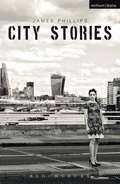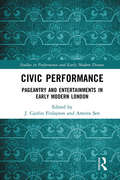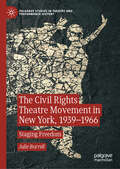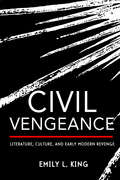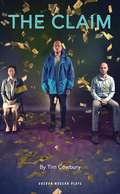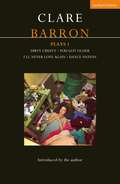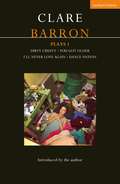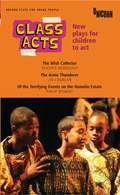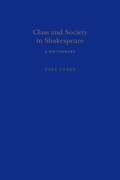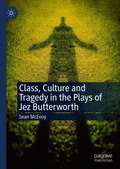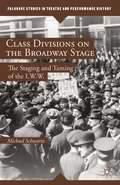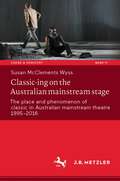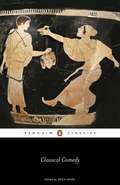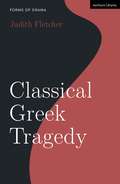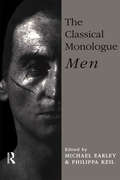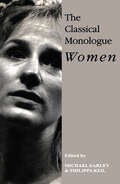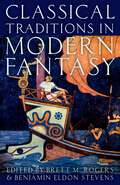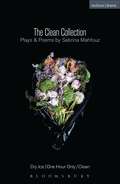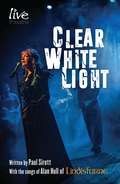- Table View
- List View
City Stories (Modern Plays)
by James PhillipsWhat happens when someone tells you that you're the answer to the riddle of life? What happens when a stranger in Starbucks gives you something that will change your world forever? What happens if the world starts to fall asleep, hour by hour?City Stories is a new type of cabaret drama, a sequence of interwoven love stories, and a love-letter to London. Composed up of five discrete yet interwoven stories, each taking the form of a monologue or duologue, and performed with specifically composed songs, City Stories looks at a variety of experiences of love and loss via a range of people living in the UK's capital. Elegantly written and beautifully constructed, these pieces look at the varieties of love and how it might save us, showing James Phillips's writing at his very best. City Stories received its world premiere at St James's Theatre, London, in 2013 and has since gone on to establish a year-long residency at the theatre.
Civic Performance: Pageantry and Entertainments in Early Modern London (Studies in Performance and Early Modern Drama)
by J. Caitlin Finlayson Amrita SenCivic Performance: Pageantry and Entertainments in Early Modern London brings together a group of essays from across multiple fields of study that examine the socio-cultural, political, economic, and aesthetic dimensions of pageantry in sixteenth and seventeenth-century London. This collection engages with modern interest in the spectacle and historical performances of pageantry and entertainments, including royal entries, progresses, coronation ceremonies, Lord Mayor’s Shows, and processions. Through a discussion of the extant texts, visual records, archival material, and emerging projects in the digital humanities, the chapters elucidate the forms in which the period itself recorded its public rituals, pageantry, and ephemeral entertainments. The diversity of approaches contained in these chapters reflects the collaborative nature of pageantry and civic entertainments, as well as the broad socio-cultural resonances of this form of drama, and in doing so offers a study that is multi-faceted and wide-ranging, much like civic performance itself. Ideal for scholars of Early Modern global politics, economics, and culture; literary and performance studies; print culture; and the digital humanities, Civic Performance casts a new lens on street pageantry and entertainments in the historically and culturally significant locus of Early Modern London.
Civic Performance: Pageantry and Entertainments in Early Modern London (Studies in Performance and Early Modern Drama)
by J. Caitlin Finlayson Amrita SenCivic Performance: Pageantry and Entertainments in Early Modern London brings together a group of essays from across multiple fields of study that examine the socio-cultural, political, economic, and aesthetic dimensions of pageantry in sixteenth and seventeenth-century London. This collection engages with modern interest in the spectacle and historical performances of pageantry and entertainments, including royal entries, progresses, coronation ceremonies, Lord Mayor’s Shows, and processions. Through a discussion of the extant texts, visual records, archival material, and emerging projects in the digital humanities, the chapters elucidate the forms in which the period itself recorded its public rituals, pageantry, and ephemeral entertainments. The diversity of approaches contained in these chapters reflects the collaborative nature of pageantry and civic entertainments, as well as the broad socio-cultural resonances of this form of drama, and in doing so offers a study that is multi-faceted and wide-ranging, much like civic performance itself. Ideal for scholars of Early Modern global politics, economics, and culture; literary and performance studies; print culture; and the digital humanities, Civic Performance casts a new lens on street pageantry and entertainments in the historically and culturally significant locus of Early Modern London.
The Civil Rights Theatre Movement in New York, 1939–1966: Staging Freedom (Palgrave Studies in Theatre and Performance History)
by Julie BurrellThis book argues that African American theatre in the twentieth century represented a cultural front of the civil rights movement. Highlighting the frequently ignored decades of the 1940s and 1950s, Burrell documents a radical cohort of theatre artists who became critical players in the fight for civil rights both onstage and offstage, between the Popular Front and the Black Arts Movement periods. The Civil Rights Theatre Movement recovers knowledge of little-known groups like the Negro Playwrights Company and reconsiders Broadway hits including Lorraine Hansberry’s A Raisin in the Sun, showing how theatre artists staged radically innovative performances that protested Jim Crow and U.S. imperialism amidst a repressive Cold War atmosphere. By conceiving of class and gender as intertwining aspects of racism, this book reveals how civil rights theatre artists challenged audiences to reimagine the fundamental character of American democracy.
Civil Vengeance: Literature, Culture, and Early Modern Revenge
by Emily L. KingWhat is revenge, and what purpose does it serve? On the early modern English stage, depictions of violence and carnage—the duel between Hamlet and Laertes that leaves nearly everyone dead or the ghastly meal of human remains served at the end of Titus Andronicus—emphasize arresting acts of revenge that upset the social order. Yet the subsequent critical focus on a narrow selection of often bloody "revenge plays" has overshadowed subtler and less spectacular modes of vengeance present in early modern culture.In Civil Vengeance, Emily L. King offers a new way of understanding early modern revenge in relation to civility and community. Rather than relegating vengeance to the social periphery, she uncovers how facets of society—church, law, and education—relied on the dynamic of retribution to augment their power such that revenge emerges as an extension of civility. To revise the lineage of revenge literature in early modern England, King rereads familiar revenge tragedies (including Marston's Antonio's Revenge and Kyd's The Spanish Tragedy) alongside a new archive that includes conduct manuals, legal and political documents, and sermons. Shifting attention from episodic revenge to quotidian forms, Civil Vengeance provides new insights into the manner by which retaliation informs identity formation, interpersonal relationships, and the construction of the social body.
The Claim (Oberon Modern Plays)
by Tim CowburyThe Claim gently invites you into the most British of interviews, then morphs into a dizzying onslaught of bureaucracy and prejudice.A bold, imaginative response to the stories of those seeking refuge in the UK, this play asks what happens when your life is at stake and all you have to save it are your words.
Clare Barron Plays 1: Dirty Crusty; You Got Older; I'll Never Love Again; Dance Nation (Contemporary Dramatists)
by Clare BarronIn recent years Clare Barron has emerged as one of the most acclaimed and exciting new voices in American drama.The first ever collection of her work, this volume contains I'll Never Love Again, You Got Older, Dance Nation and Dirty Crusty.I'll Never Love AgainA theatrical chamber piece about first love, first heartbreak and how those early teenage experiences haunt the rest of our lives, I'll Never Love Again was created from the playwright's real high school diary, and recalls the anguish and mysteries of sex and love during adolescence.You Got OlderMae returns home to help take care of Dad and – maybe (a little) – herself. You Got Older is a tender and darkly comic new play about family, illness, and cowboys – and how to remain standing when everything you know comes crashing down around you.Dance NationSomewhere in America, an army of pre-teen competitive dancers plots to take over the world. And if their new routine is good enough, they'll claw their way to the top at the Boogie Down Grand Prix in Tampa Bay. Yet these young dancers have more than choreography on their minds, as every plié and jeté is a step toward finding themselves and unleashing their power.Dirty CrustyJeanine is determined to improve her life. With sex. With dance. With new hobbies, like horticulture. But self-improvement is hard. Reclaiming your dreams is hard. And personal hygiene is really, really hard.
Clare Barron Plays 1: Dirty Crusty; You Got Older; I'll Never Love Again; Dance Nation (Contemporary Dramatists)
by Clare BarronIn recent years Clare Barron has emerged as one of the most acclaimed and exciting new voices in American drama.The first ever collection of her work, this volume contains I'll Never Love Again, You Got Older, Dance Nation and Dirty Crusty.I'll Never Love AgainA theatrical chamber piece about first love, first heartbreak and how those early teenage experiences haunt the rest of our lives, I'll Never Love Again was created from the playwright's real high school diary, and recalls the anguish and mysteries of sex and love during adolescence.You Got OlderMae returns home to help take care of Dad and – maybe (a little) – herself. You Got Older is a tender and darkly comic new play about family, illness, and cowboys – and how to remain standing when everything you know comes crashing down around you.Dance NationSomewhere in America, an army of pre-teen competitive dancers plots to take over the world. And if their new routine is good enough, they'll claw their way to the top at the Boogie Down Grand Prix in Tampa Bay. Yet these young dancers have more than choreography on their minds, as every plié and jeté is a step toward finding themselves and unleashing their power.Dirty CrustyJeanine is determined to improve her life. With sex. With dance. With new hobbies, like horticulture. But self-improvement is hard. Reclaiming your dreams is hard. And personal hygiene is really, really hard.
Class Acts: New Plays for Children to Act (Oberon Plays for Young People)
by Philip Osment Oladipo Agboluaje Lin CoghlanThe Wish Collector by Oladipo Agbolauje: A magical epic whirling from a playground in Britain to a village in Sierra LeoneThe Acme Thunderer by Lin Coghlan: A funny, moving family drama of pigeons and siblings, set amid the Blitz.Of the Terrifying Events on the Hamelin Estate by Philip Osment: A high-spirited contemporary satire bringing the Pied Piper legend up-to-date.Three 30 minute plays by leading playwrights for children to act, commissioned by the Unicorn, one of the world’s foremost companies creating theatre with young people. Premiered as end of year performances by primary classes, the scripts are ideal school productions or for younger youth theatre groups. They are designed to be directed by teachers or youth leaders with no previous drama training. The book includes advice and ideas to support preparation, rehearsal and production.
Class and Society in Shakespeare (Continuum Shakespeare Dictionaries)
by Paul InnesThe Continuum Shakespeare Dictionaries provide authoritative yet accessible guides to the principal subject-areas covered by the plays and poetry of Shakespeare. The dictionaries provide readers with a comprehensive guide to the topic under discussion, its occurrence and significance in Shakespeare's works, and its contemporary meanings. Entries range from a few lines in length to mini-essays, providing the opportunity to explore an important literary or historical concept or idea in depth. Entries include: apothecary, bear-baiting, Caesar, degree, gentry, Henry V, kingdom, London, masque, nobility, plague, society, treason, usury, whore and youth. They follow an easy to use three-part structure: a general introduction to the term or topic; a survey of its significance and use in Shakespeare's plays and a guide to further reading.
Class, Culture and Tragedy in the Plays of Jez Butterworth
by Sean McEvoyJez Butterworth is undoubtedly one of the most popular and commercially successful playwrights to have emerged in Britain in the early twenty-first century. This book, only the second so far to have been written on him, argues that the power of his most acclaimed work comes from a reinvigoration of traditional forms of tragedy expressed in a theatricalized working-class language. Butterworth’s most developed tragedies invoke myth and legend as a figurative resistance to the flat and crushing instrumentalism of contemporary British political and economic culture. In doing so they summon older, resonant narratives which are both popular and high-cultural in order to address present cultural crises in a language and in a form which possess wide appeal. Tracing the development of Butterworth’s work chronologically from Mojo (1995) to The Ferryman (2017), each chapter offers detailed critical readings of a single play, exploring how myth and legend become significant in a variety of ways to Butterworth’s presentation of cultural and personal crisis.
Class Divisions on the Broadway Stage: The Staging and Taming of the I.W.W. (Palgrave Studies in Theatre and Performance History)
by M. SchwartzExamining twenty-five years of theatre history, this book covers the major plays that feature representations of the Industrial Workers of the World. American class movement and class divisions have long been reflected on the Broadway stage and here Michael Schwartz presents a fresh look at the conflict between labor and capital.
Classic-ing on the Australian mainstream stage: The place and phenomenon of classic in Australian mainstream theatre 1995-2016 (Szene & Horizont. Theaterwissenschaftliche Studien #11)
by Susan McClements WyssThis book evaluates classic drama as an active creation. To classic is a complex theatrical practice that animates program choice, casting and staging, audience reception and critical response. Analysis of six distinct examples of pre-determined and self-nominated classic productions on the Australian mainstage is informed by postcolonial theory, specifically the settler dilemma of Indigenous cultural authority. What happens to the political edge of postcolonial aspiration within the status of classic? Close consideration of staging and casting, theatre historical perspectives, and interviews with key artists, expands the concept of classic as a dimension of theatrical and not only of dramatic reception. This book responds to a polarised debate that focused on auteur directors and the relative value of new vs classic plays. Rather than adopting a position, the study undertakes a deeper assessment of the phenomenon and place of the dramatic classic in Australian mainstream theatre.
Classical Comedy: Five Plays By Plautus And Terence (Focus Classical Library)
by Aristophanes Menander Plautus TerenceFrom the fifth to the second century BC, innovative comedy drama flourished in Greece and Rome. This collection brings together the greatest works of Classical comedy, with two early Greek plays: Aristophanes' bold, imaginative Birds, and Menander's The Girl from Samos, which explores popular contemporary themes of mistaken identity and sexual misbehaviour; and two later Roman comic plays: Plautus' The Brothers Menaechmus - the original comedy of errors - and Terence's bawdy yet sophisticated double love-plot, The Eunuch. Together, these four plays demonstrate the development of Classical comedy, celebrating its richness, variety and extraordinary legacy to modern drama.
Classical Greek Tragedy (Forms of Drama)
by Judith FletcherClassical Greek Tragedy offers a comprehensive survey of the development of classical Greek tragedy combined with close readings of exemplary texts. Reconstructing how audiences in fifth-century BCE Athens created meaning from the performance of tragedy at the dramatic festivals sponsored by the city-state and its wealthiest citizens, it considers the context of Athenian political and legal structures, gender ideology, religious beliefs, and other social forces that contributed to spectators' reception of the drama. In doing so it focuses on the relationship between performers and watchers, not only Athenian male citizens, but also women and audiences throughout the ancient Mediterranean world.This book traces the historical development of these dynamics through three representative tragedies that span a 50 year period: Aeschylus' Seven Against Thebes, Sophocles' Oedipus Tyrannus, and Euripides' Helen. Topics include the role of the chorus; the tragic hero; recurring mythical characters and subject matter; Aristotelian assessments of the components of tragedy; developments in the architecture of the theater and their impact on the interactions of characters, and the spaces they occupy. Unifying these discussions is the observation that the genre articulates a reality beyond the visible stage action that intersects with the characters' existence in the present moment and resonates with the audience's religious beliefs and collective psychology. Human voices within the performance space articulate powerful forces from an invisible dimension that are activated by oaths, hymns, curses and prayers, and respond in the form of oracles and prophecies, forms of discourse which were profoundly meaningful to those who watched the original productions of tragedy.
Classical Greek Tragedy (Forms of Drama)
by Judith FletcherClassical Greek Tragedy offers a comprehensive survey of the development of classical Greek tragedy combined with close readings of exemplary texts. Reconstructing how audiences in fifth-century BCE Athens created meaning from the performance of tragedy at the dramatic festivals sponsored by the city-state and its wealthiest citizens, it considers the context of Athenian political and legal structures, gender ideology, religious beliefs, and other social forces that contributed to spectators' reception of the drama. In doing so it focuses on the relationship between performers and watchers, not only Athenian male citizens, but also women and audiences throughout the ancient Mediterranean world.This book traces the historical development of these dynamics through three representative tragedies that span a 50 year period: Aeschylus' Seven Against Thebes, Sophocles' Oedipus Tyrannus, and Euripides' Helen. Topics include the role of the chorus; the tragic hero; recurring mythical characters and subject matter; Aristotelian assessments of the components of tragedy; developments in the architecture of the theater and their impact on the interactions of characters, and the spaces they occupy. Unifying these discussions is the observation that the genre articulates a reality beyond the visible stage action that intersects with the characters' existence in the present moment and resonates with the audience's religious beliefs and collective psychology. Human voices within the performance space articulate powerful forces from an invisible dimension that are activated by oaths, hymns, curses and prayers, and respond in the form of oracles and prophecies, forms of discourse which were profoundly meaningful to those who watched the original productions of tragedy.
The Classical Monologue (M): Men
by Michael Earley Philippa KeilThe Classical Monologue in two volumes, one for men and one for women, is a fresh selection of the best speeches from the repertoire of the classical theatre, from the Greeks to the beginning of the 20th century. These great dramatic monologues--from all periods and styles, all varied in tone and genre--make an indispensable actor's companion for auditioning, rehearsing and performing. Each monologue is accompanied by textual notes explaining any unusual vocabulary or syntax, and by commentary in which the editors offer interpretative points and practical advice in preparing the speech for performance. Both beginners and experienced actors will find The Classical Monologue a treasury of theatrical riches waiting to be released on stage.
The Classical Monologue (M): Men
by Michael Earley Philippa KeilThe Classical Monologue in two volumes, one for men and one for women, is a fresh selection of the best speeches from the repertoire of the classical theatre, from the Greeks to the beginning of the 20th century. These great dramatic monologues--from all periods and styles, all varied in tone and genre--make an indispensable actor's companion for auditioning, rehearsing and performing. Each monologue is accompanied by textual notes explaining any unusual vocabulary or syntax, and by commentary in which the editors offer interpretative points and practical advice in preparing the speech for performance. Both beginners and experienced actors will find The Classical Monologue a treasury of theatrical riches waiting to be released on stage.
The Classical Monologue (W): Women
by Michael EarleyFirst Published in 1993. Routledge is an imprint of Taylor & Francis, an informa company.
The Classical Monologue (W): Women
by Michael Earley Philippa KeilFirst Published in 1993. Routledge is an imprint of Taylor & Francis, an informa company.
Classical Traditions in Modern Fantasy
Classical Traditions in Modern Fantasy is the first collection of essays in English focusing on how fantasy draws deeply on ancient Greek and Roman mythology, philosophy, literature, history, art, and cult practice. Presenting fifteen all-new essays intended for both scholars and other readers of fantasy, this volume explores many of the most significant examples of the modern genre-including the works of H. P. Lovecraft, J. R. R. Tolkien's The Hobbit, C. S. Lewis's Chronicles of Narnia, J. K. Rowling's Harry Potter series, George R. R. Martin's Game of Thrones series, and more-in relation to important ancient texts such as Aeschylus' Oresteia, Aristotle's Poetics, Virgil's Aeneid, and Apuleius' The Golden Ass. These varied studies raise fascinating questions about genre, literary and artistic histories, and the suspension of disbelief required not only of readers of fantasy but also of students of antiquity. Ranging from harpies to hobbits, from Cyclopes to Cthulhu, and all manner of monster and myth in-between, this comparative study of Classics and fantasy reveals deep similarities between ancient and modern ways of imagining the world. Although antiquity and the present day differ in many ways, at its base, ancient literature resonates deeply with modern fantasy's image of worlds in flux and bodies in motion.
CLASSICAL TRADITIONS IN MODERN FANTASY C
by Brett M. Rogers and Benjamin Eldon StevensClassical Traditions in Modern Fantasy is the first collection of essays in English focusing on how fantasy draws deeply on ancient Greek and Roman mythology, philosophy, literature, history, art, and cult practice. Presenting fifteen all-new essays intended for both scholars and other readers of fantasy, this volume explores many of the most significant examples of the modern genre-including the works of H. P. Lovecraft, J. R. R. Tolkien's The Hobbit, C. S. Lewis's Chronicles of Narnia, J. K. Rowling's Harry Potter series, George R. R. Martin's Game of Thrones series, and more-in relation to important ancient texts such as Aeschylus' Oresteia, Aristotle's Poetics, Virgil's Aeneid, and Apuleius' The Golden Ass. These varied studies raise fascinating questions about genre, literary and artistic histories, and the suspension of disbelief required not only of readers of fantasy but also of students of antiquity. Ranging from harpies to hobbits, from Cyclopes to Cthulhu, and all manner of monster and myth in-between, this comparative study of Classics and fantasy reveals deep similarities between ancient and modern ways of imagining the world. Although antiquity and the present day differ in many ways, at its base, ancient literature resonates deeply with modern fantasy's image of worlds in flux and bodies in motion.
The Clean Collection: Dry Ice; One Hour Only; Clean and poems (Modern Plays)
by Sabrina MahfouzA dynamic collection of three of Sabrina Mahfouz's pieces for the theatre, published alongside a selection of her poetry.Dry Ice A critically acclaimed solo show about a young stripper, which was produced at by the Underbelly (Edinburgh) and the Bush Theatre (London) and directed by David Schwimmer. It played at the Contact (Manchester), the Soutbank Centre (London) and the Bush (London) as part of Madani Younis's debut season in 2012.One Hour OnlyAn 'upmarket' brothel. It's Forensic Biology student Marley's first night at her new job and AJ – twenty-one, good-looking and intelligent – is her unexpected first client. One Hour Only formed part of the Old Vic New Voices' first ever Edinburgh Season at the Underbelly in association with IdeasTap.CleanZainab, Chloe & Katya, London's best 'clean' criminals and perpetrators of victimless crime, are forced together in an unlikely trio. This feisty trio soon become the unlikely action heroes of an adventure left to men. A short play commissioned by the Traverse Theatre, 2012, Clean was part of the A Play, A Pie & A Pint Season at Òran Mor, Glasgow and The Traverse Theatre, Edinburgh.
The Clean Collection: Dry Ice; One Hour Only; Clean and poems (Modern Plays)
by Sabrina MahfouzA dynamic collection of three of Sabrina Mahfouz's pieces for the theatre, published alongside a selection of her poetry.Dry Ice A critically acclaimed solo show about a young stripper, which was produced at by the Underbelly (Edinburgh) and the Bush Theatre (London) and directed by David Schwimmer. It played at the Contact (Manchester), the Soutbank Centre (London) and the Bush (London) as part of Madani Younis's debut season in 2012.One Hour OnlyAn 'upmarket' brothel. It's Forensic Biology student Marley's first night at her new job and AJ – twenty-one, good-looking and intelligent – is her unexpected first client. One Hour Only formed part of the Old Vic New Voices' first ever Edinburgh Season at the Underbelly in association with IdeasTap.CleanZainab, Chloe & Katya, London's best 'clean' criminals and perpetrators of victimless crime, are forced together in an unlikely trio. This feisty trio soon become the unlikely action heroes of an adventure left to men. A short play commissioned by the Traverse Theatre, 2012, Clean was part of the A Play, A Pie & A Pint Season at Òran Mor, Glasgow and The Traverse Theatre, Edinburgh.
Clear White Light (Oberon Modern Plays)
by Paul SirettA contemporary retelling of a classic gothic story, inspired by Edgar Allan Poe’s The Fall of the House of Usher, set against a background of cuts to our 70-year-old NHS.Alison is heading to her first shift at St Nicholas’s Hospital in Gosforth. She’s nervous. It’s a night shift on an all-male psychiatric unit and she hasn’t finished her training yet. But Rod, the senior Staff Nurse, seems to know what to do. Take a deep breath...Inspired by Alan Hull’s time working at St Nick’s the play features many of the hit songs he wrote at that time, including Winter Song, Lady Eleanor and Clear White Light played by a live band. Live Theatre wants to bring this incredible music to a new generation.Clear White Light is based on Edgar Allan Poe’s short story The Fall of the House of Usher and written by Olivier Award-nominated writer Paul Sirett.
